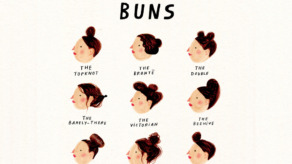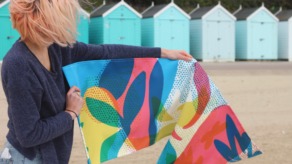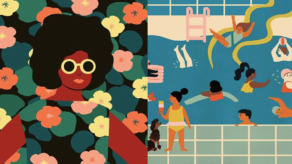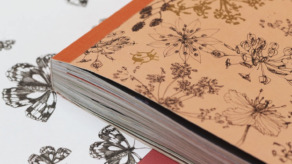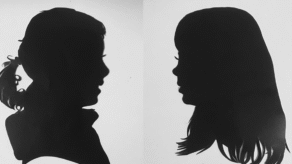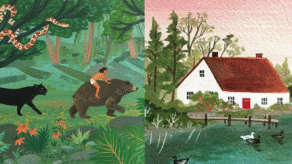Dutch illustrator Lize Prins fell in love with Seoul
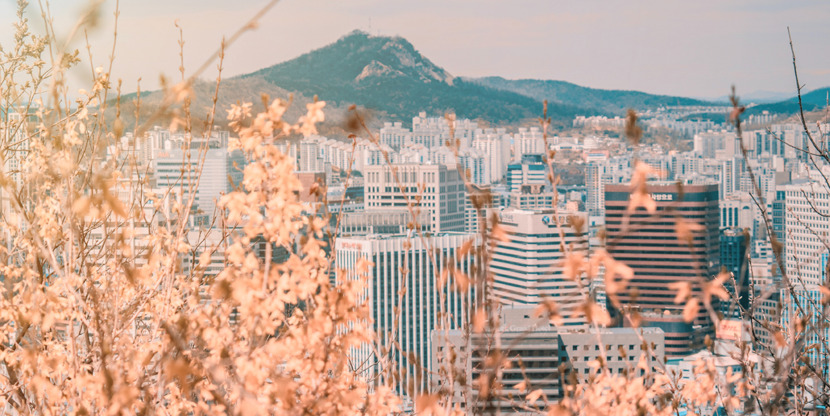
South Koreans spend a lot of time working, but they are also great believers in taking time to relax. Journalist Caroline Buijs visits Dutch illustrator Lize Prins who fell in love with Seoul so much that she decided to stay.
Illustrator Lize Prins has been interested in Japanese and Korean music, illustrations and animations since she was eleven years old. “According to my mother, I even once downloaded a Korean language course to my computer when I was a child,” she says, “but I don’t remember.” In 2016, Prins went on a vacation to Seoul for a month with her best friend, at the end of which they decided to stay.
“Because it’s really refreshing that everything is so completely different than in the Netherlands,” she explains. “The way people dress, the food, the culture, the street scene—everything is a huge inspiration for me in my work. But fortunately, when I recently showed my illustrations to a Korean movie director friend of mine, he said he could see that my work is different from that of Korean illustrators, so luckily its influence isn’t too big.”
Picnics in Central Park
The university district of Hongdae is one of Prins’ favorite neighborhoods, full of busy cafés, restaurants and quirky shops. In the evenings, there are street performances by K-pop dance groups—particularly popular among Chinese tourists.
Another of Prins’ favorite neighborhoods is Yeonnam-dong, where she lives, and it is right next to Hongdae. Seoul is enormous—with 9.8 million inhabitants—but it also has a cluttered and friendly atmosphere because it wasn’t built up per neighborhood, but per house: Onto each existing house, a new house is built. Prins lives in an octapbang: an apartment built on a rooftop, with a small roof terrace.
Seoul has an extensive metro network, but we go everywhere on foot. On our way to a picture book café, we walk through the Yeonnam-dong park, which used to be a railway and is now a large public space. Koreans like to call it Yeontral Park because then it almost sounds like New York’s Central Park. When the weather is nice, it fills up with people having picnics.
Fun social things together
“Koreans work hard and a lot,” Prins says, “but they also like to spend their money on doing fun social things together. Most young people live at home until they marry, so they prefer getting together outside. When you meet up with your friends, you usually bring a ready-made dish; many supermarkets are open 24 hours a day.
There are plastic chairs and tables in front of the stores, where you can have a drink with your purchased snacks. Or you can have your food delivered to the park. You get a phone call when your delivery driver has arrived on their scooter. It’s really funny to see everyone rushing to the park entrance to pick up their food.”
Beer and Picture Books
After we arrive at the ‘For picture book lovers’ café, we take our shoes off and place them in a locker, where a pair of slippers is waiting for us. We hand over the key at the bar and order what has quickly become my new favorite drink: a matcha latte. With Chet Baker playing in the background, we saunter over the glossy wooden floor in our slippers and settle down in a kind of reading pit.
On almost every wall a bookcase reaches all the way to the ceiling, filled with graphic novels and photo books (mainly of cats) and picture books. Most covers are facing forward, making it easy to choose a book. There are plenty of Korean books, of course, but because most of them contain almost no text, there is no language barrier.
Library and bookstore
The picture book café feels like a cross between a library and a bookstore, except that you can’t buy or borrow the books; you simply read and look at them right here and now, while in the café. That gives me a pleasant and unexpectedly peaceful feeling. I don’t have to decide whether I want to buy or borrow one of these beautiful books; I can just enjoy them.
We each gather a stack of books and return to our reading pit. “A place like this perfectly reflects the Koreans’ idea that you also need to carve out space to rest and relax,” Prins says. Which is plain to see when you look around: not only are there tables, chairs and a reading pit, there are also a few cabins with beds—kind of like sleeping compartments on trains. Not to take a nap on, but to sprawl comfortably on while you thumb through the picture book of your choice.
I notice that people who are sitting in the café together are also browsing their books quietly—not chatting with each other all the time. “I like the fact that it’s not just parents who come here with their children,” says Prins, “but also young people—boys as well as girls. And no one is surprised when an adult sits alone browsing through picture books: Koreans just really like pictures. You can also order a beer here, by the way, isn’t that a funny combination? Beer and picture books!”
Your Nose
“Koreans think it is very important for things to be aesthetically pleasing,” Prins says, as we go to find a place for lunch. “They pay a lot of attention to their own appearance, but also to design in general. Their love of beautiful things is reflected in everything: in book covers, packaging, the interior design of stores, but also in a simple paper bag, for example.
And they love brands here. When Ikea opened its first store in Seoul a few years ago, you suddenly saw people walking down the street with the blue-and-yellow Ikea logo on their T-shirts, or on their socks or belts—of course it was being used illegally.”
Kakao Talk
Big brands often join forces with Kakao Friends, popular characters that are available as dolls and that you also see in the Korean messaging app, Kakao Talk. I think they look a bit childish, but they love them in Seoul. “I recently went to a small museum dedicated to Kakao, so now I know a bit more about the background of some of the characters,” Prins says.
“For example, there’s Ryan who, at first glance, looks like a sweet teddy bear, but who is actually a lion that has lost his mane and is a little insecure as a result.”
Prins says that, sometimes, Koreans go quite far in their desire for everything to look beautiful. When you apply for a job here, for example, it’s generally understood that if all the applicants are equally suitable, the best-looking candidate will be selected. “For that reason, some young people receive plastic surgery as a gift for their birthday,” Prins says.
“Their parents hope it will help them in their career. I’ve regularly experienced people wanting to touch my nose—they like big noses—and then asking if it is real. I worked in a club for a while where a co-worker immediately started talking about the size of my nose and said that his own nose was fake. He wasn’t ashamed of it. But not everyone is so candid.”
Just Like a Village
When we reach the lunchroom around the corner from Prins’ house, we are greeted enthusiastically by a friendly woman who knows exactly what Prins likes to eat: gimbap, a local variation of sushi. Korea was under Japanese rule from 1910 to 1945 and that’s how sushi was introduced there. The dressing for the rice is different, as are the seaweed sheets and the filling. In Japan it often consists of fish, in South Korea it is usually meat.
“The bigger your meal, the more side dishes are served with it, but there is always kimchi,” Prins tells me. Kimchi is a typically South Korean dish, often spicy, made of one or more pickled vegetables. “Every family makes their own supply of pickles every year; they even have an extra refrigerator for storing their produce.”
Because Prins has some local favorites and has contact with people in the area, Seoul is increasingly feeling like a village to her. “I often come to this lunchroom,” she says. “I teach the owner some English words and get to practice my Korean with her.
I also talk to people from our local supermarket and the bakery. There the shop girl always sets aside this bread for me that I really like—with red beans and chestnuts. Because I find the normal bread here too soft and sweet.”
A Sheep Café
After lunch, we walk back to the busier Hongdae neighborhood, where Prins shows me stores full of pens, decorative washi tape, notebooks, writing pads, calendars, stickers, posters and cards—all equally beautiful. I already feasted my eyes on tons of beautiful stationery when I was in Tokyo, but in Seoul the wares on offer are even more varied and I gain a new appreciation for how this city must be paradise for
an illustrator.
In the busy shopping street, a girl is holding up a sign advertising a meerkat café. “People often live in very small houses and, what’s more, young people stay with their parents for quite a long time,” Prins explains. “Owning your own pet is not that common, although it is becoming increasingly popular. So instead you have meerkat cafés such as that one, but there are also dog, cat and raccoon cafés. There’s even one with sheep.”
Differences
Apart from the many animal cafés, Prins has found a number of striking differences between Seoul and her native country: “Koreans are much more free and easy with their money,” she says. “When you eat out you don’t split the bill. Instead, one person pays for everything and then somebody else will next time—it’s a very natural way of taking turns.
People also don’t seem to live by such a set routine here, which makes it easier to spontaneously arrange something. When you ask people in the evening if they want to go for a drink, they almost always say yes. What’s also funny is that where I am from, you usually start a text chat by asking, ‘How are you?’, but here the first sentence is, ‘What are you doing?’
Koreans call you much faster than in the Netherlands, and everyone immediately swaps in their ‘old’ phone if there is a new model—even the older people. I do find Koreans can be a little negative sometimes though. When you ask how it’s going, they immediately start complaining that they’re so tired. In my culture, we tend to do that less, but perhaps we’re also too quick to say that things are going well—even if they are not.”
Sweet Potato and Milk
Prins has noticed that Koreans follow very strict social conventions. “If you are the youngest in a group, you’re the one who refills the drinks in a restaurant or lays the cutlery on the table, for example,” she says. “And when you drink, you turn your head to the side when you take your sip as it is considered disrespectful to show an older person the bottom of your glass.
There are also many different ways to address each other correctly, depending on whether someone is older or younger, male or female. If you are from the same birth year, you often immediately become ‘friends’, I have also noticed. People relax then; they can ease the social conventions a bit, because you’re the same age.
Sometimes they exchange telephone numbers and take pictures with each other. Everyone from the same year is also the same age, because a person’s age always shifts on January 1 here. And when you are born you are immediately one instead of zero years old.”
Safe on the streets
After a drink of sweet potato with whipped milk at the Red Big Space café (where everyone is taking selfies in front of a wall full of plastic flowers), we go looking for Veronica Effect, a graphic novel bookstore that Prins hasn’t been to yet. She found out about it on Naver, a South Korean search engine. In the evening, after we have eaten in a bibimbap restaurant (bibimbap is a dish of warm rice, egg and various vegetables), Prins walks me back to my hotel in the dark.
She says that she always feels safe on the streets here in the evenings and at night. “When I first came here, the threat emanating from the tempestuous relationship between Donald Trump and Kim Jong-un was in the news a lot, and that felt pretty worrisome to me,” she says.
“But the South Koreans themselves seemed to shrug their shoulders about it; they are used to political unrest. And then I noticed that I was especially affected by news about Korea that came from the Netherlands, told from a Dutch perspective, but not so much by the way it was reported here.”
Moving back to the Netherlands
When I ask her if she already knows how long she wants to stay in Seoul, Prins says that she has just decided to move back to the Netherlands. “It’s been a great adventure and I have learned a lot, also about myself,” she says.
“For example, that I am very European, and ultimately feel more at home there than anywhere else. So now I want to focus on making a lot of new work in peace—away from cultural differences and language barriers. Not only for magazines, but also for myself. And after that I’ll charge myself up for the next adventure: Berlin for example. But I wouldn’t be surprised if after a while I get in the mood for oriental horizons again and go off to Japan.”
About the Correspondent
- Caroline stayed at the Marigold Hotel. She visited Lize Prins in Seoul before the COVID-19 pandemic.
- Take a look at the website of Lize Prins.
- Text Caroline Buijs Photography Cait Ellis/Unsplash.com
